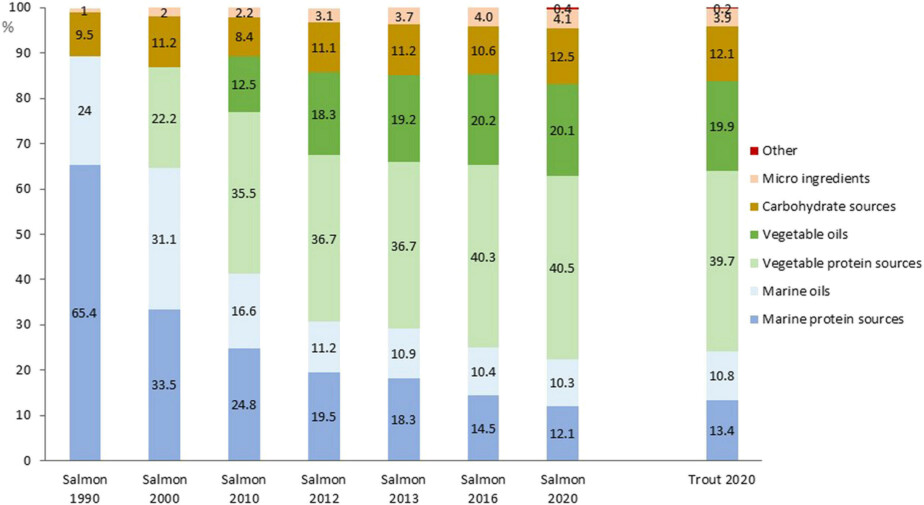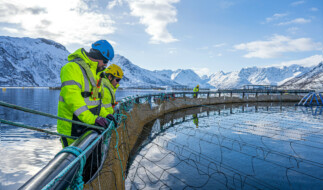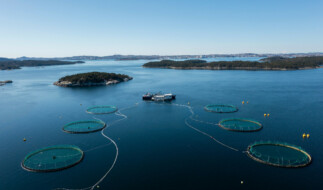Farmed salmon is a highly nutritious and healthy source of protein, and a major contributing factor to this is the specialized diet of the fish, which is rich in nutrients and Omega-3s. Ensuring the future sustainability of these feed ingredients is very important to us as responsible farmers.
Feed sourcing
Like many industries, our success relies on the availability and high quality of our raw materials. For farmed salmon, this is the raw ingredients, marine and plant-based, that make up our salmon feed. We are conscious of the possible environmental and social risks that may be connected to our ingredients, and are committed to improving responsible sourcing, transparency, and innovation across our supply chains to reduce these risks.
Ongoing evolutions
Through our collective efforts within GSI, we are working on a number of approaches to improve the sustainability of current ingredient sourcing and support the development and addition of new ingredients.
Our efforts here include:
- Developing an Environmental Social Governance (ESG) Feed Risk Assessment Tool that allows GSI farmers to engage proactively in conversations with their feed suppliers on supply chain risks to support long-term improvements.
- Working in partnership with WWF on a project to align GHG emissions for salmon aquaculture, including feed, and accelerating mitigation efforts to reduce the carbon footprint of our feed which currently is a large contributor to our overall footprint.
- Supporting the development and implementation of the new ASC Feed Standard, which was launched in 2021, and working with our supply chain partners to implement this as an additional stage in our responsible sourcing practices.
- Stimulating the development of novel EPA+DHA rich fish oils through the launch of a 2017 call-to-action and tender for innovative sources.
- Improving transparency on feed ingredient use via company reporting in GSI's annual Sustainability Report.
- Continuing to share best-practices along the supply chain on improving feed efficiencies to reduce the fish-in-fish-out ratio, and maximize the use of sustainable by-products.
- We are also in continuous dialogue with our partners and stakeholders such as WWF and FAIRR to better understand where and how we can improve our feed-sourcing policies.
Frequently asked…
What do farmed salmon eat?
Farmed salmon eat a highly specialized diet to obtain all the nutrients they need to thrive. These diets typically include a mix of protein, vitamins, and minerals and are rich in omega-3s which keep the fish healthy, and also support many health benefits we get from consuming salmon.
As responsible salmon farmers, we are always looking for ways to improve the sustainability of our feed ingredients to reduce our footprint and look for innovative ways to keep the fish healthy and nutritious.
Innovation
Salmon feeds and diets are always evolving to both improve on sustainability of sourcing and meet evolving needs of the fish and the environment. Below is an example showing how the composition of salmon feed in Norway has evolved over time.
While the diet was historically marine dependent, this has drastically reduced as the industry has improved efficiencies in feeding, identified alternatives and utilized more by-products. This profile will continue to evolve in future years as new ingredients become available and we learn more about the sustainability profile.

Our supply chains need to be transparent and demonstrate responsible use of resources. Which is why, through our partnerships with our Associate Members BioMar, Cargill, Skretting, and Salmofood, and our work with the ASC, we hope to accelerate development of new solutions and approaches to improving the sustainability and traceability of feed ingredients, while maintaining our position as an industry leader in environmental performance.
Improvements in forage fish dependency ratios and feed conversion ratios
Making sense of the acronyms:
Forage Fish Dependency Ratio (FFDR) is the amount of wild fish needed in feed to produce 1 kg of farmed salmon. Feed Conversion Ratio (FCR) is the amount of feed an animal requires to gain 1 kg of body weight. The lower the FFDR, the lower the inclusion percentage of wild fish. The lower the FCR, the more efficient an animal is in retaining the protein and energy from the feed and converting it into food for humans.
Thanks to ongoing innovations in salmon aquaculture over the past 20 years, the feed industry has reduced the amount of fish meal from 65% to 18%, and fish oil from 24% to 11%, and reduced FCR from 2.4:1 to 1.15:1, while maintaining optimal diets for the salmon and high-quality nutrition for humans. This has resulted in farmed salmon having one of the lowest feed conversion ratios of all animal proteins, but we are continuously working to reduce this further.

As a fairly young industry, this is a significant development in a short span of time. We plan to continue these innovations to further reduce our impact on marine resources.
In addition, through our partnership with the Food and Agriculture Organization (FAO) of the United Nations (UN), we have been able to transfer this knowledge to other developing aquaculture sectors to promote improved sustainability across the sector as a whole. We will continue to look for ways to both improve the feed efficiencies in salmon but also more broadly across aquaculture.
Certifications for sustainable feed ingredients
The Aquaculture Stewardship Council (ASC) has developed the ASC Feed Standard to certify that sourcing of feed ingredients and the feed mills they are processed in meet strict environmental and social requirements. GSI members are committed to working towards the ASC Salmon Standard across their farms. Our members and associate feed companies will be using this standard as a framework to promote greater transparency in the supply chain and ensure that all ingredients are responsibly sourced.
Learn more about the areas where collaborative innovation is driving significant progress:
Continued developments
Feed ingredients play an important role in the efficiency of salmon farming and provide the salmon with all the protein and essential nutrients required for optimal health and growth and contribute to the many health benefits we get from eating salmon. For GSI, our role is to help the industry maintain this nutritional profile, while reducing environmental impacts.




